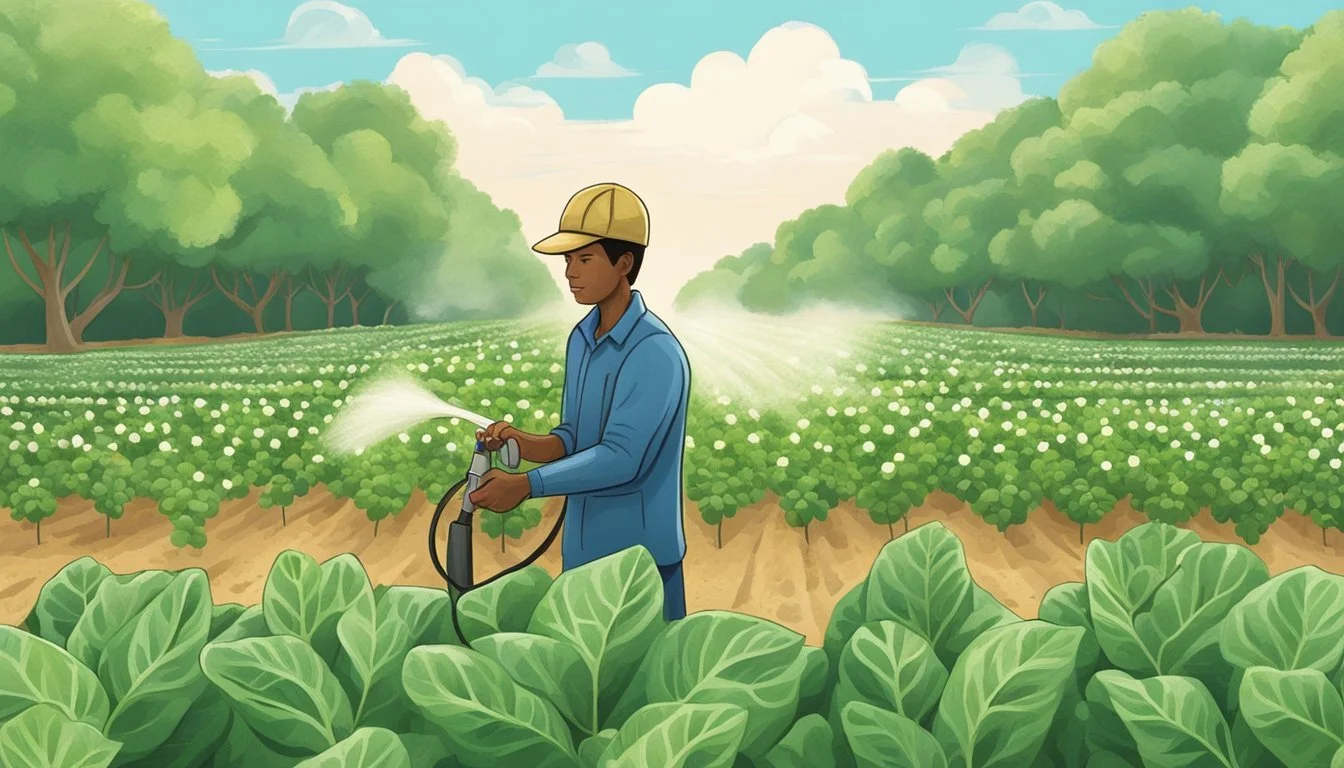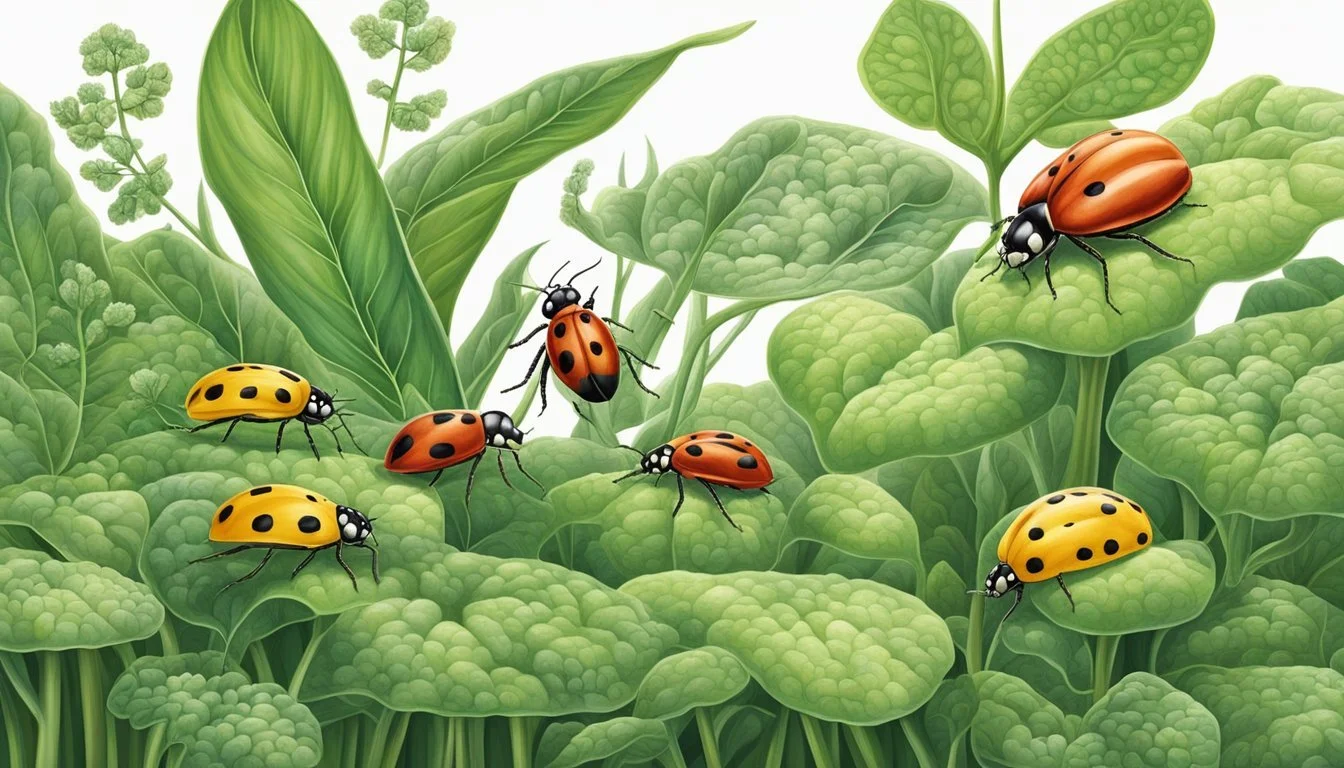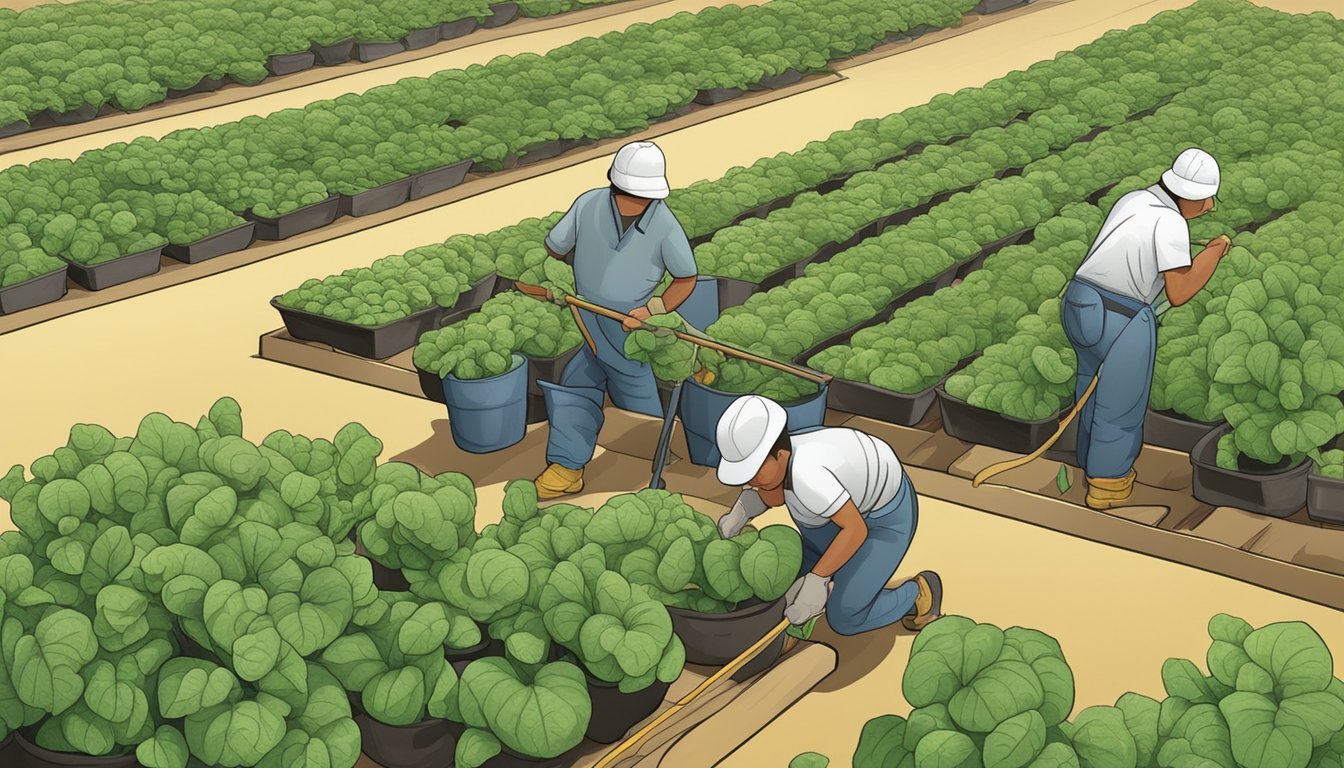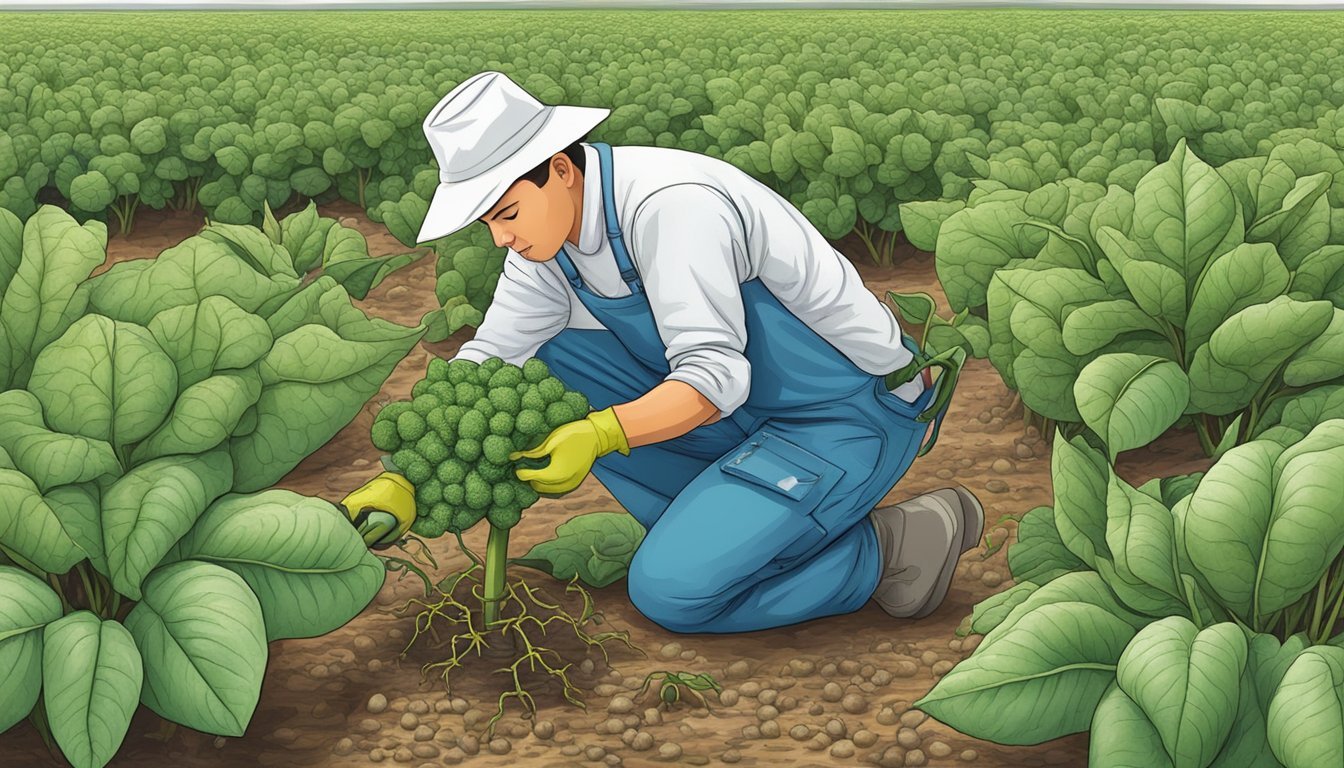Pest Control for Jicama
Effective Strategies for Healthy Crops
Jicama, also known as yam bean or Mexican turnip, is a root vegetable native to Mexico and Central America, prized for its crunchy texture and sweet, nutty flavor. Consumed both raw and cooked, it is a versatile ingredient utilized in various dishes such as salads, stir-fries, salsas, or simply as a healthy snack. The growth of this tuberous root in the home garden has gained popularity due to its delicious taste and nutritional benefits.
However, like any plant, jicama requires specific conditions to thrive and produce its best yield. One important aspect of growing jicama is effective pest control. Fortunately, the plant has few pest problems, but it's still crucial to monitor and manage any potential threats to ensure a healthy, robust crop. Proper care and preventative measures can minimize the risk and impact of pests, making pest control a manageable task for gardeners who aspire to harvest top-quality jicama.
Understanding Jicama
Before diving into the specifics of jicama pest control, it's essential to grasp the fundamentals of jicama itself. From its origins to its nutritional profile, understanding these elements lays the groundwork for successful cultivation.
Botanical Profile
Jicama (Pachyrhizus erosus) originates from Central America and Mexico, making it a staple in many Latin cuisines. It is a root vegetable known for its edible tubers, which grow under a vigorous vine. The plant produces flowers and beans, though they are typically not consumed due to toxicity.
Nutritional Values
Jicama is low in calories but high in fiber. One cup of jicama contains about 49 calories and 6.4 grams of dietary fiber. Nutrition-wise, it's an excellent source of vitamin C, providing about 44% of the recommended daily value. It also contributes modest amounts of iron to the diet.
Optimal Growing Conditions
For optimal growth, jicama requires consistent warmth as it's sensitive to frost. It thrives in a climate with full sun exposure and temperatures ideally between 70°F and 90°F. The plant prefers humidity levels that are moderate to high. Jicama is best planted in well-drained soil with a soil pH between 6.0 and 7.0, and needs regular watering to maintain moist conditions without waterlogging.
Jicama Varieties
Several varieties of jicama exist, each with subtle differences in texture and flavor. The flesh is generally crunchy and mildly sweet. The most common are large, round tubers with light brown skin, found in grocery stores. Other varieties might vary in size and shape, with some being more fibrous or sweeter.
The understanding of these foundational elements of jicama equips gardeners with the knowledge to effectively prevent and address pest-related challenges.
Cultivation Techniques
In cultivating jicama, understanding the specifics of soil preparation, planting, and ongoing care ensures a healthy growth period. Adhering to each step can yield a robust crop of this root vegetable.
Soil Preparation
Healthy jicama cultivation begins with soil preparation. Jicama thrives in sandy, well-drained soil that is rich in organic matter. Prior to planting, it's crucial to work compost into the soil to improve drainage and nutrient content. A soil pH between 6.0 and 7.0 is optimal for jicama plants.
Planting Instructions
Planting jicama starts with either seeds or seedlings. Plant seeds about half an inch deep, using fresh, viable seed stock. For seedlings, ensure they are transplanted at the same soil depth as they were in containers. Jicama also requires a warm climate to germinate and grow effectively, with a preference for full sun exposure.
Watering and Nutrition
Jicama requires regular watering, especially during its crucial early growth period. Supply about 2 inches of water per week. Nutritional needs should be met with a balanced fertilizer containing potassium, phosphorus, and nitrogen. A potassium-rich plant food may be particularly beneficial.
Support and Spacing
As jicama vines can grow quite extensive, providing support, such as a trellis, is essential for optimal growth and air circulation. It's recommended to space plants approximately 10-15 feet apart to accommodate their sprawling nature and substantial size at maturity.
Dealing with Shade
While jicama prefers full sun, it's necessary to manage shade appropriately. Insufficient sunlight can hinder growth, so it's important to monitor and perhaps prune nearby foliage to ensure each plant receives adequate light throughout the day.
Pest Management
Effective pest management in jicama cultivation is essential to ensure a healthy crop. Adhering to proactive measures can minimize damage from pests and diseases, which include implementing a range of control methods suited to the crop's needs.
Common Pests
Jicama plants are generally resilient to pests, but they are not immune. The most prevalent pest that concerns jicama growers are aphids. These tiny insects feed on the underside of leaves and can be managed through vigilant monitoring.
Disease Prevention
Disease prevention is crucial for maintaining the health of jicama plants. One of the common diseases that affect jicama is root rot, which often results from poorly drained soil. To prevent this, ensure soil is well-aerated and water does not stagnate.
Organic Pest Control
Employing organic pest control methods is a sustainable approach to managing pests. One effective strategy is the introduction of beneficial insects that prey on aphids. Additionally, enhancing the soil with organic matter can help develop healthy plants that are less prone to disease.
Pesticides and Treatments
In cases where pest populations are significant, pesticides and treatments might be necessary. When choosing pesticides, it's important to opt for products that are specifically labeled for use on jicama to avoid harming the plant or the surrounding environment. For more information on an Integrated Pest Management (IPM) approach that combines various methods, one can refer to guidelines for pest and disease control in jicama cultivation.
Harvesting and Storage
Properly harvesting and storing jicama ensures maximum yield and preserves the quality of the tubers. From recognizing the right time to harvest to employing correct techniques and ensuring suitable post-harvest care, each step is crucial. Saving seeds for future planting can also be an important part of the jicama harvesting process.
When to Harvest
Jicama reaches maturity and is ready for harvest approximately four to nine months after planting, depending on the growing conditions. One should harvest jicama when the leaves begin to yellow but before frost, as the root becomes tough after a hard freeze.
Harvesting Techniques
To harvest jicama, carefully loosen the soil around the plant using a spading fork or shovel. Gently lift the tubers out, taking care to avoid cutting or bruising them. Each plant yields large, edible root tubers, which are the primary harvest from jicama cultivation.
Post-Harvest Care
After harvesting, clean the tubers of soil and allow them to dry for a few hours in a shaded, well-ventilated area. For storage, keep the jicama in a cool, dry place. If placed in the refrigerator, they can last for a few weeks, while in a cool, dry storage area, they may last up to several months.
Seed Saving
When saving seeds for future planting, select healthy jicama plants that exhibit desirable characteristics. Allow seed pods to dry on the plant until they are brown and crack open easily. Store the seeds in a cool, dry place until the next planting season, making sure to label the container with the date and variety of jicama.
Jicama in Cuisine
Jicama brings a unique flavor and crunchy texture to a variety of dishes, serving as a versatile ingredient in both raw and cooked forms. It is enjoyed for its freshness in salads, stir-fries, salsas, and as a nutritious snack.
Preparation and Serving Ideas
Jicama can be served raw or cooked, with its mild taste and crunchy texture making it a refreshing addition to meals. It is commonly incorporated in salads, where it adds a fresh crunch. For a simple preparation, peel and slice jicama into sticks and enjoy them as a snack with a sprinkle of lime juice and a dash of chili powder.
Salads: Add julienned jicama for a crispy, refreshing element.
Stir-fries: Combine with other vegetables and protein for a quick, flavorful meal.
Salsas: Jicama pairs well with fruits like mango or pineapple to create a delicious salsa.
One popular way to enjoy jicama is by making chips. Thinly sliced and baked jicama chips serve as a healthier alternative to traditional potato chips and can be seasoned with various spices.
Pairing Flavors
Jicama's subtle sweetness and nutty flavor make it compatible with a wide array of flavor profiles. It pairs well with:
Citrus fruits: Lime or lemon juice accentuates jicama's freshness.
Spices: Chili powder or paprika complements its sweetness with heat.
Herbs: Cilantro or mint can add a burst of herbal notes.
Due to its neutral taste, jicama can also balance out stronger flavors in dishes such as spicy stir-fries or flavorful salsas, making it a delightful ingredient to have in the culinary repertoire.
Special Considerations
When managing pests in jicama cultivation, one must pay close attention to various specifics beyond general care. The plant's sensitivity to climate, potential toxicity, and specific growth requirements, such as container cultivation and crop rotation, are crucial for a successful harvest.
Toxicity Awareness
Jicama plants contain rotenone, a natural insecticide, which reduces the need for chemical pest control. However, growers must be aware that the seeds and foliage of jicama are poisonous if ingested by humans or animals. This toxicity must be communicated to those involved in the growing process to prevent accidental ingestion.
Climatic Limitations
Jicama thrives in warm climates and can be severely impacted by temperatures below 50°F. It is sensitive to frost, requiring gardeners to ensure that the growing environment consistently stays above this critical threshold. If cultivated in cooler regions, adjustments to the growing season or protective measures like row covers might be necessary.
Growing in Containers
For gardeners with limited space or non-ideal soil conditions, jicama can be successfully grown in containers. These should be adequately sized to accommodate the plant's growth, with attention paid to providing enough space for the roots to expand. Good drainage is key to prevent waterlogging and to foster healthy root development.
Importance of Crop Rotation
Crop rotation is essential in jicama cultivation, as it helps in the care and management of soil nutrients and pest populations. Rotating jicama with other crops minimizes the risk of soil-borne diseases and maintains soil fertility, contributing to the healthy growth of subsequent plantings.
Advancing Jicama Agriculture
In pursuit of enhancing jicama cultivation, it is essential to concentrate on innovative research, sustainable methods, and community initiatives, all while ensuring knowledge is widely disseminated among stakeholders.
Research and Development
Research and development in the field of jicama agriculture are pivotal for extending the growing season and increasing the viability of this vegetable in the United States. Agricultural research is harnessing genetic studies to develop varieties that can thrive in a wider range of climates and soils. Ongoing trials aim to optimize yield and disease resistance, which could result in jicama being a more attractive option for gardeners and commercial farmers alike.
Sustainable Farming Practices
The adoption of sustainable farming practices is critical for the advancement of jicama agriculture, ensuring environmental health and long-term productivity. Techniques such as crop rotation, organic farming, and the integration of natural pest control strategies are being implemented to minimize ecological impact. By relying on organic fertilizers and promoting biodiversity, farmers contribute to a sustainable future for jicama cultivation.
Community Gardening
Community gardening initiatives have been instrumental in popularizing jicama among local gardeners. These collective efforts not only augment the diversity of vegetables grown at the local level but also empower community members with the skills necessary for growing this nutritious root. Furthermore, community gardens act as living laboratories for experimenting with different jicama cultivars and organic growth strategies, fostering a shared learning environment.
Education and Outreach
Efforts in agricultural education are crucial for the proliferation of knowledge regarding jicama agriculture. Outreach programs, workshops, and extension services help spread best practices and innovations to gardeners and farmers. They cover a wide array of topics, from optimal planting techniques to effective pest management, equipping individuals with the necessary knowledge to produce jicama successfully and sustainably.
Frequently Asked Questions
The health and productivity of jicama plants hinge on effective pest management and solid cultivation practices. This section addresses these essential topics through specific questions frequently posed by gardeners.
What are common pests that affect jicama and how can they be managed?
Jicama is typically resistant to pests but may encounter issues with aphids, spider mites, and less commonly, fungal diseases. These pests can be managed by promoting healthy plant growth, which naturally outcompetes them, and through the careful application of insecticides or natural predators like ladybugs for aphids.
How does one effectively take care of a jicama plant throughout its growing season?
Jicama plants require a sunny location, consistent moisture, and a well-drained soil rich in potassium. Moreover, they need approximately 2 inches of water per week and regular feeding with a potassium-rich plant food to support robust root development, according to Premeditated Leftovers.
Are there specific companion plants that benefit jicama growth, and what are they?
Information regarding companion plants specifically beneficial to jicama growth is not provided within the search results; thus, further research from credible gardening resources is recommended for gardeners interested in companion planting.
What measures can be taken to grow jicama organically without the use of high levels of pesticides?
To minimize pesticide use, the gardener can rely on mulching and the strategic cultivation of vigorous plants to suppress weeds, deterring pests. Additionally, Utah State University suggests shallow cultivation to avoid disturbing jicama roots when necessary.
Can you provide tips for successfully growing jicama in varying climates, such as Arizona or California?
Jicama thrives in warm climates and may not tolerate cold. For climates like Arizona or California, which offer warmer environments, planting after the threat of frost has passed is ideal. In cooler regions, consider using a greenhouse or moving container-grown plants to a sheltered location when temperatures drop, as advised by Epic Gardening.
During which season is it best to plant jicama, and what is its typical growth cycle?
Plant jicama seeds two months prior to the expected last frost date. Soak seeds overnight before planting to enhance germination. Expect seedlings to emerge within a few weeks, and the typical growth cycle of jicama, from planting to harvest, spans approximately 5 to 9 months, depending on the climate, as outlined by Better Homes & Gardens.









